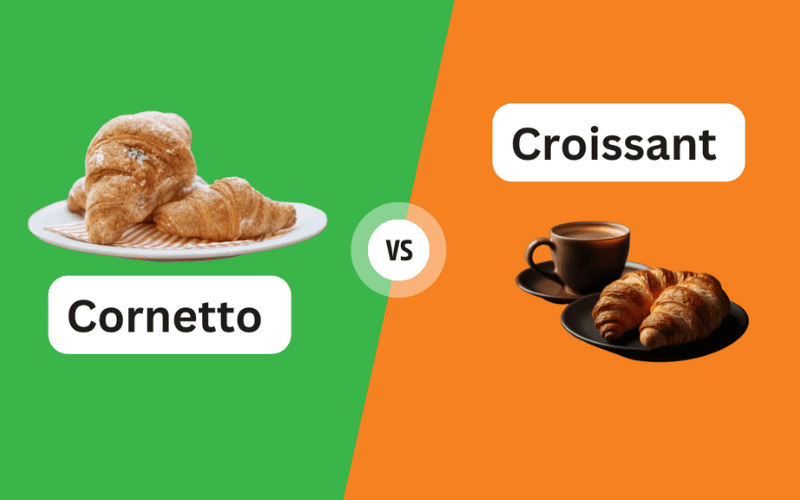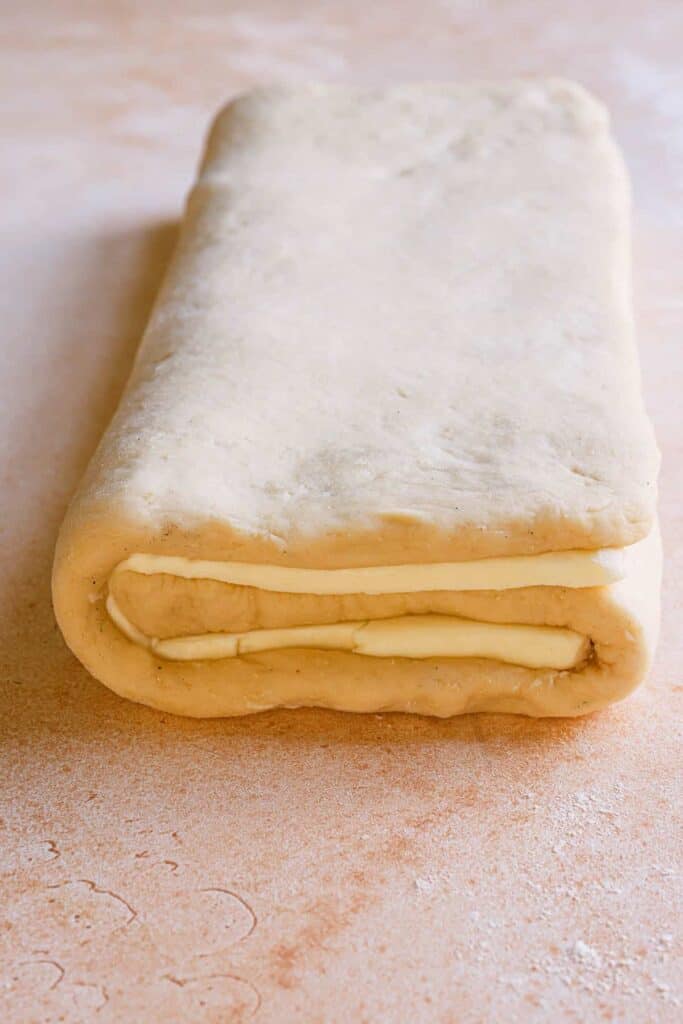When it comes to enjoying a delicious pastry, the choices can be overwhelming. Two popular options that often come to mind are the cornetto and the croissant. But, There’s often confusion between cornetto and croissant, as both are popular pastries that share some similarities. Let’s indulge in a delicious debate of flavors with Cornetto vs. Croissant
However, they have distinct differences in taste, texture, and origin. Understanding these differences can help individuals make a more informed decision when choosing between the two.
By examining the ingredients, preparation, and cultural significance of both pastries, we can determine the best choice for your taste buds. In this article, I will explore the unique features of both the cornetto and the croissant, and provide a solution for those who are looking to satisfy their sweet cravings.
Let’s dive into the world of cornetto and croissant to find out which one suits your preferences!
Where Do The Cornetto And The Croissant Originate?
Before you know which one is best, let’s head to their intro! The Cornetto and the Croissant are two popular pastries that have gained worldwide recognition and are enjoyed by millions of people.
To understand their origins, we need to dive into their individual histories.
The Cornetto

The Cornetto Italian,a popular ice cream cone, traces its roots back to the early 16th century. It was first mentioned in the works of the Italian writer Bartolomeo Platina, who described a dessert called “cornetto” in his book “De Honestate Vitae.”
The Cornetto was initially made of thin, crispy wafer and filled with various sweet ingredients, such as ice cream, cream, or fruit.
Over time, the cornetto recipe evolved, and the modern Cornetto, with its ice cream-filled wafer cone, was born.
The Croissant

The Croissant, on the other hand, has a rich and fascinating history that dates back to 17th-century Austria. It was created by Austrian bakers who were looking for a way to use up the excess bread dough left over after the failed Siege of Vienna by the Ottoman Empire in 1683.
The bakers decided to incorporate butter into the dough, which was a rare and expensive ingredient at the time. They shaped the dough into a crescent, a symbol of the Ottoman Empire, as a way to mock their enemies. The resulting pastry, known as the Kipfel, was light, flaky, and buttery, quickly gaining popularity throughout Europe.
The Difference Between A Cornetto And A Croissant
When it comes to choosing between both a cornetto and a croissant, there are several key differences between croissant and cornetto. As someone who has a passion for pastries and baked goods, I have had the pleasure of indulging in both of these delectable treats on numerous occasions.
Here’s my personal perspective on the main differences between a cornetto and a croissant.

Flavor and Texture
One of the primary differences between a cornetto and a croissant lies in their flavor and texture. A croissant is typically flaky, buttery, and has a light, airy texture. The layers of dough are folded with butter, resulting in a rich and indulgent taste.
On the other hand, a cornetto, which is an Italian variation of the croissant, often has a slightly sweeter taste due to the addition of sugar in the dough. The texture of a cornetto can also be denser compared to a traditional croissant, with a slightly more substantial bite.
Shape and Presentation
In terms of shape and presentation, both pastries have distinct differences. A croissant is typically crescent-shaped with curved edges, while a cornetto often has a more elongated shape with pointed ends.
Additionally, when it comes to presentation, a cornetto may be glazed or dusted with powdered sugar for added sweetness, whereas a classic croissant is often left unadorned, allowing its golden-brown exterior to speak for itself.
Cultural Variations
Another important aspect to consider is the cultural variations associated with these pastries. While the croissant is synonymous with French pastry culture and is enjoyed worldwide, the cornetto holds significant cultural importance in Italy.
In Italy, cornetti are commonly enjoyed for breakfast or as a snack, often accompanied by a cappuccino or espresso. The Italian version may also include fillings such as cream, jam, or chocolate, adding another layer of diversity to this beloved pastry.
Cornetto Vs Croissant Costco

At Costco, I had to choose between a Cornetto and a Croissant. The Cornetto brought a sweet explosion with its creamy ice cream and chocolatey tip.
Meanwhile, the Croissant offered a buttery, flaky delight that felt like a bakery treat. Unable to decide, I went for both – a combo of sweet crunch and comforting buttery layers from Costco’s delicious options!
However, in terms of Cornetto vs Croissant calories, cornetto tends to be higher due to sweet fillings, while Croissants vary but often have less.
Cornetto Vs Croissant Vs Brioche
Lately, I found myself in a tasty dilemma at Costco, torn between a Cornetto, a Croissant, and a Brioche. The Cornetto was a sweet delight with its creamy ice cream and chocolatey tip, hitting the spot for my sweet tooth.
The Croissant, all buttery and flaky, gave me a cozy bakery vibe that I couldn’t resist. Then there was the Brioche, soft and slightly sweet, making it a unique contender.
In the end, I couldn’t decide, so I went for the trio – a crunchy-sweet Cornetto, a buttery Croissant, and a soft, delightful Brioche. Costco turned into a mini food adventure for me!
Italian Cornetto Vs French Croissant

I was torn between an Italian Cornetto and a French Croissant, and let me tell you, it was a tough choice. The Italian Cornetto had this sweet surprise with its creamy ice cream and chocolatey tip – a burst of flavors in every bite. On the other hand, the French Croissant was all about buttery, flaky layers, transporting me to a cozy Parisian bakery with each bite.
The Cornetto was like a dessert adventure, satisfying my sweet cravings, while the Croissant was a classic indulgence, with its rich buttery taste. In the end, it really depends on whether you’re in the mood for a sweet treat or a comforting, buttery pastry. Both have their charm, making it a delicious dilemma that I happily faced!
Cornetto Bread Vs Croissant
Choosing between Cornetto bread and croissants depends on your taste preferences. Cornetto bread leans towards sweetness, akin to a dessert bread with various fillings, while croissants delight with their buttery and flaky layers, making them a classic breakfast treat. Whether you crave a sugary twist or a traditional pastry experience, both options offer distinct flavors for different palates.
Cornetto Pastry Vs Croissant
The choice between Cornetto pastry and croissants hinges on flavor and texture preferences. Cornetto pastries, often sweet and filled, provide a dessert-like indulgence. In contrast, croissants boast a classic buttery and flaky profile, making them a delightful breakfast option. Selecting between these two options boils down to whether you’re in the mood for a sugary treat or a timeless, buttery pastry experience.
Nutritional Facts
| Nutrient | Cornetto | Croissant |
| Calories | 250-300 kcal | 200-300 kcal |
| Fat | 10-15 g | 12-15 g |
| Saturated Fat | 4-6 g | 6-8 g |
| Trans Fat | 0-1 g | 0-1 g |
| Cholesterol | 10-20 mg | 10-20 mg |
| Sodium | 150-250 mg | 100-200 mg |
| Carbohydrates | 30-40 g | 30-40 g |
| Dietary Fiber | 1-2 g | 1-2 g |
| Sugars | 10-15 g | 5-10 g |
| Protein | 4-6 g | 4-6 g |
Croissant Vs Cornetto Which Is Better?
Personally, I prefer croissants over cornettos. The buttery, flaky layers of a croissant are unmatched in texture and flavor. The simplicity of a classic croissant allows the buttery richness to shine through, making it a perfect accompaniment to a cup of coffee or tea.
On the other hand, while cornettos are delicious with their sweet fillings and toppings, they can sometimes be overly sweet for my taste. Additionally, the texture of a croissant is more satisfying to me as it offers a delightful crunch with each bite. Overall, the versatility and rich flavor of a croissant make it my preferred choice over a cornetto.
How To Recognize Whether A Brioche Is Of Good Quality?
Know that when assessing the quality of a brioche, there are several key indicators to consider. As an avid baker and pastry enthusiast, I have honed my ability to recognize a good brioche through years of experience and learning from experts in the field.
Appearance
When examining a brioche, the first thing I look for is its appearance. A high-quality brioche should have a rich golden-brown color on the outside, indicating that it has been properly baked. The surface should be smooth and slightly shiny, with an even distribution of any toppings or glazes. Additionally, the shape of the brioche should be uniform and free from any deformities.
Texture
Upon touching the brioche, I pay attention to its texture. A good brioche should feel soft, airy, and slightly springy to the touch. When torn apart, it should reveal a delicate crumb structure with small air pockets, indicating that it has been kneaded and proofed correctly. The texture should not be overly dense or dry, as these are signs of poor quality.
Aroma
The aroma of a brioche can also provide valuable insights into its quality. A freshly baked brioche should exude a buttery and slightly sweet fragrance that is both inviting and comforting. This aroma is a result of using high-quality ingredients and proper fermentation techniques during the baking process.
Taste
Finally, the most crucial aspect of assessing a brioche’s quality is its taste. A well-made brioche should have a rich buttery flavor with subtle hints of sweetness. The texture in the mouth should be light and airy, melting away with each bite. It should not taste overly greasy or bland but instead offer a satisfying balance of flavors.
How To Make Cornetti?
When it comes to making Cornetti, there are several steps to follow to ensure a delicious and flaky pastry. Here’s a breakdown of the process:
Prepare The Butter

First, you need to prepare the butter for layering in the dough. Start by softening the butter at room temperature. Then, using a fork or a butter cutter, beat the butter until it becomes smooth and creamy. This will make it easier to spread the butter between the layers of dough.
Make The Dough
In a large bowl, combine flour, sugar, salt, and yeast. Mix them together well. Then, add lukewarm water and olive oil to the mixture. Stir everything together until a soft dough forms. Knead the dough on a lightly floured surface for about 10 minutes, or until it becomes smooth and elastic. Once the dough is ready, shape it into a ball and place it in a greased bowl. Cover the bowl with a clean cloth and let the dough rise in a warm place for about an hour or until it doubles in size.
Locking The Butter
After the dough has risen, roll it out on a lightly floured surface into a rectangle, about 1/4-inch thick. Now, spread the softened butter evenly over the surface of the dough, leaving a 1/2-inch border along the edges.

Folding

Fold the dough in thirds, like a letter. First, fold the bottom third of the dough up to the center, then fold the top third down over the bottom third. This will create three layers of dough with butter in between. Wrap the dough in plastic wrap and refrigerate for 30 minutes.
Shaping
After the dough has chilled, roll it out again into a rectangle, about 1/4-inch thick. Fold the dough in thirds once more, then shape it into a tight ball. Place the dough on a baking sheet lined with parchment paper and cover it with a clean cloth. Let the dough rest for another 30 minutes.

Final Shaping and Baking
Preheat your oven to 375°F (190°C). Roll out the dough once more into a large rectangle, about 1/4-inch thick. Using a sharp knife or pizza cutter, cut the dough into long strips, about 1-inch wide. Take each strip and roll it up tightly, starting from the wide end and finishing at the narrow end. Place the rolled-up strips on a baking sheet lined with parchment paper, leaving some space between them for expansion. Let the Cornetti rest for another 15 minutes before baking.


Expert Tips
Now that you know how to make Cornetti, let’s dive into the expert tips to perfect this delicious pastry.
Prepare the Butter
To ensure a flaky and tender Cornetto, it’s essential to use cold butter. Start by cubing the butter into small pieces and then place them in the freezer for about 15 minutes before using them. This will help maintain the butter’s cold temperature while working with the dough.
Make the Dough
In a large bowl, combine flour, sugar, and a pinch of salt. Mix them well. Then, add cold cubed butter to the dry ingredients and use your fingertips to rub the butter into the flour until the mixture resembles coarse crumbs. Next, add a cold egg and cold water to the mixture, and using a fork, stir until the dough starts to come together. If needed, use your hands to gently bring the dough together. Wrap the dough in plastic wrap and refrigerate for at least 30 minutes.
Locking the Butter
Once the dough has chilled, roll it out on a lightly floured surface into a rectangle shape. Evenly distribute the softened butter on the dough, leaving a small border at the edges. Fold the dough into thirds, like folding a letter, and then fold it again in the same manner. This will ensure that the butter is evenly distributed throughout the dough and will create a flaky texture.
Folding and Shaping
After locking the butter, roll out the dough again into a rectangle shape. Fold the dough in thirds once more, making sure to maintain the shape. Repeat this folding process two more times, making sure to chill the dough for at least 30 minutes between each folding. This will create numerous layers in the dough, resulting in a light and flaky Cornetto.
Conclusion
In conclusion, both Cornetto and Croissant have their unique characteristics, flavors, and textures that cater to different tastes and preferences. While the Cornetto offers a delightful combination of ice cream, wafer, and toppings, the Croissant presents a flaky, buttery pastry that can be enjoyed in various forms, such as plain, filled with sweet or savory ingredients, or even as a dessert with ice cream or chocolate.
Ultimately, the choice between a Cornetto and a Croissant comes down to personal preference and the specific cravings of the individual. Both treats have their own merits and can be enjoyed at different times and occasions. To make an informed decision, one should consider factors such as taste, texture, and dietary restrictions.
FAQs
What Is The Difference Between A Croissant And A Cornetto?
The main difference between a croissant and a Cornetto lies in their texture and flavor; a croissant is flaky and buttery, while a Cornetto has a sweeter, often filled, pastry.
Which Came First Cornetto Or Croissant?
The croissant came first, originating in Austria, while the Cornetto, an Italian adaptation, gained popularity later.
Why Do Italians Call Croissants Cornetto?
Italians call croissants “cornetto” due to their similar crescent shape, although the two pastries have distinct tastes and textures.
What Do Italians Call Pain Au Chocolat?
Italians refer to pain au chocolat as “girella al cioccolato” or “cornetto al cioccolato,” adapting the name to their own pastry variations.








